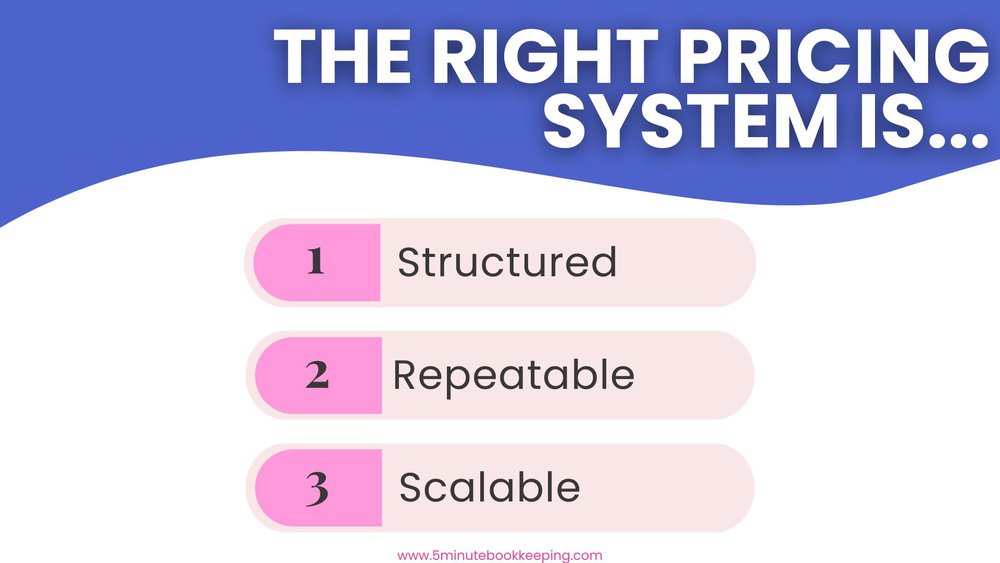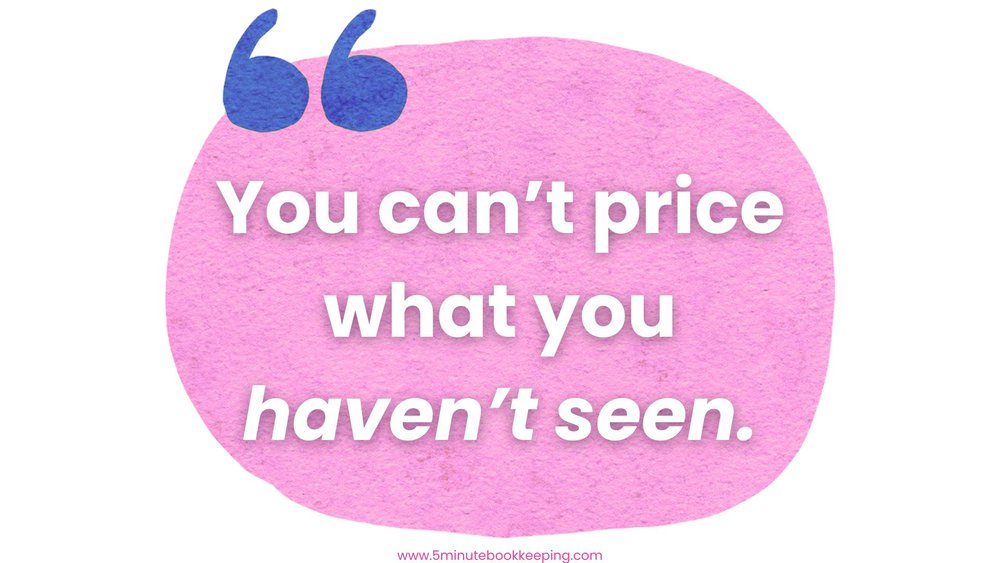
Let’s be honest— pricing is one of the most anxiety-inducing topics for bookkeepers. I’ve been there. The thought of quoting a price would send me into a spiral of overthinking, stress, and avoidance. If you’ve ever delayed sending a proposal because you were too nervous to give a price, you’re not alone.
I used to spend hours creating detailed pricing spreadsheets, adding more variables in a desperate attempt to find the “perfect formula” for pricing my services. Spoiler alert: I never used those spreadsheets. Instead, I learned some valuable lessons that helped me move from pricing panic to profit.
Pricing Isn’t Personal – It’s Professional
One of the biggest hurdles to confident pricing isn’t the math but the emotions that come with it. We worry clients will think we’re greedy if we charge too much. We second-guess our skills and wonder if we’re “good enough” to raise our rates. These fears don’t just live in our heads, though. They create a cycle of avoidance, guilt, resentment, and chronic undercharging.
What makes it even harder is how often we tie our self-worth to our prices. If a client pushes back or says “that’s too expensive,” it feels like a personal rejection, not just a business conversation. But here’s the truth: pricing is not a reflection of your character, your worthiness, or your abilities. It’s the cost of your time, expertise and solutions to solve real problems. Because the clients who truly value what you offer? They’ll respect you even more for setting fair, firm prices.
Know Your Value
One of the most important lessons I had to learn was to stop projecting my own attitudes about money onto my clients. Just because I love a bargain or look for deals doesn’t mean my clients are hunting for the cheapest option. In fact, many clients are actively seeking out experts they can trust. They’re not looking for the lowest price; they’re looking for the best solution to their problem.
That’s why defining your ideal client is key. When you know who you’re best equipped to serve, you can price your services based on the value you bring, not on what you think people are willing to pay. As my confidence and expertise grew, so did my pricing. I went from charging $150/month when I first started—just hoping to land clients—to charging $1,500/month for clients who understood the value of working with a specialized expert. Pricing isn’t about convincing everyone to hire you. It’s about finding the right clients who are willing and able to pay for the results you deliver.
Simplifying Pricing
One of the biggest breakthroughs in my pricing journey was realizing I needed a structured, repeatable process. Pricing had to become simple, efficient, and scalable—otherwise, it would continue to drain my time and confidence.

Here are the key lessons I learned along the way:
1. Stop Worrying About What Everyone Else Charges: It’s easy to fall into the comparison trap. You’ll always find someone charging more than you—and someone charging less. But their business, their skills, and their goals are not yours. Pricing isn’t about keeping up with competitors; it’s about building a sustainable business that supports your life and reflects the value you bring.
2. Set a Target Average Hourly Rate: Instead of trying to micromanage the price of every individual service, decide on an average hourly rate you want to earn across your client base. For example, you might aim for an average of $100/hour. Not every client will hit that number exactly—some will be a little above, some below—but the goal is to have your overall workload balance out to that average. This keeps you profitable while offering flexibility.
3. Track, Monitor, and Adjust Regularly: Pricing isn’t a “set it and forget it” process. You need to continuously monitor how much time you’re spending per client and whether you’re hitting your target hourly rate. Are certain clients requiring more hours than expected? Are some services taking longer because of inefficiencies? Use this information to make informed adjustments—whether it’s streamlining workflows, raising prices, or reassessing service scope. Data-driven decisions take the guesswork out of pricing.
4. Know When It’s Time to Let Go: As your business grows and you attract higher-paying, more aligned clients, you’ll inevitably outgrow some of your early clients. And that’s okay. It’s part of scaling your business. If a client isn’t willing or able to pay your updated rates, it may be time to respectfully part ways. Letting go of low-paying or high-maintenance clients opens up space for the clients who truly value your expertise and are happy to pay for it.
5. Keep It Simple, Always: The simpler your pricing system, the more confidently you can communicate it to clients. Develop a formula that works for you, whether it’s based on transaction volume, revenue percentages, or service packages. The goal isn’t to create a perfect pricing model—it’s to create one that’s easy for you to use, easy for clients to understand, and flexible enough to grow with your business.
Pricing Conversations Don’t Have to Be Scary
Talking about pricing gets easier when you strip out the emotion. Practice saying, “The price for this service is…” and eliminate words like “fee” or “rate.” Use neutral, direct language. My biggest advice is to stop using commas when typing out prices in proposals or emails—it makes large numbers feel less overwhelming.
When a prospect asks, “What do you charge?” respond with:
“Thanks for asking! I customize my pricing based on the complexity of each client’s books. The first step is a paid diagnostic review to assess the scope of work and provide an accurate quote. Would you like me to explain how that works?”
Pricing Methods That Work
You can’t price what you haven’t seen. Always diagnose first, whether that’s a paid diagnostic review or at minimum, a smart review of their QBO file.

For ongoing services, I found that percentage-of-revenue pricing (1-3%) is the simplest method. It saved me time and took out the guesswork. Transaction-based pricing (per transaction or per bank account) works too, but it gets tedious. Find what fits your workflow and stick with it.
Closing & Resources
Pricing doesn’t have to be the dreaded part of your business. With a clear process, a confident mindset, and a willingness to value your expertise, you can turn those nerve-wracking pricing conversations into simple, professional discussions. Remember—your knowledge is worth it, and the right clients will gladly pay for the clarity and peace of mind you bring to their books.
Looking for more resources? Here is a link to get my free Smart Review Checklist so you can learn how to review your prospective clients books in 15 minutes or less. You can also visit my 5MB Academy to see a full list of my QuickBooks Online cleanup related courses and resources linked here. As always, I’d like to invite you to join my 5 Minute Bookkeeping Community on Facebook to connect with fellow bookkeepers. It’s a safe place to ask questions and share your journey. I hope to see you there!















